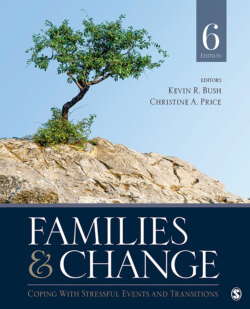Читать книгу Families & Change - Группа авторов - Страница 20
На сайте Литреса книга снята с продажи.
Coping
ОглавлениеFamily stress researchers have increasingly shifted their attention from crisis and family dysfunction to the process of coping. Researchers have become more interested in explaining why some families are better able to manage and endure stressor events rather than documenting the frequency and severity of such events (e.g., Henry et al., 2015). In terms of intervention, this represents a change from crisis intervention to prevention (Boss, 1988; McCubbin et al., 1980; McCubbin & McCubbin, 2013).
The study of family coping has drawn heavily from cognitive psychology (e.g., Lazarus, 2006; Lazarus & Folkman, 1984) as well as sociology (e.g., Pearlin & Schooler, 1978; McCubbin, 2006). Cognitive coping strategies refer to the ways in which individual family members alter their subjective perceptions of stressful events. Sociological theories of coping emphasize a wide variety of actions directed at either changing the stressful situation or alleviating distress by manipulating the social environment (McCubbin et al., 1980; McCubbin & McCubbin, 2013). Thus family coping has been conceptualized in terms of three types of responses: (a) direct action (e.g., acquiring resources, learning new skills); (b) intrapsychic (e.g., reframing the problem); or (c) controlling the emotions generated by the stressor (e.g., social support, use of alcohol; Boss, 1988; Lazarus, 2006; Lazarus & Folkman, 1984; Pearlin & Schooler, 1978). These responses can be used individually, consecutively, or, more commonly, in various combinations. Specific coping strategies are not inherently adaptive or maladaptive; they are very much situation specific (e.g., Folkman & Moskowitz, 2004; Yeh et al., 2006). Flexible access to a range of responses appears to be more effective than the use of any one response (Moos, 1986; Yeh et al., 2006). Coping interacts with both family resources and perceptions as defined by the B and C factors of the ABC-X model. However, coping actions are different than resources and perceptions. Coping represents what people do—their concrete efforts to deal with a stressor (Folkman & Moskowitz, 2004; Pearlin & Schooler, 1978). Having a resource or a perception of an event does not imply whether or how a family will react (Boss, 1988; Lazarus & Folkman, 1984; Yeh et al., 2006).
Although coping is sometimes equated with adaptational success (i.e., a product), from a family systems perspective, coping is a process, not an outcome per se. Coping refers to all efforts expended to manage a stressor regardless of the effect (Lazarus, 2006; Lazarus & Folkman, 1984). Thus, the family strategy of coping is not instantly created but is progressively modified over time. Because the family is a system, coping behavior involves the management of various dimensions of family life simultaneously: (a) maintaining satisfactory internal conditions for communication and family organization, (b) promoting member independence and self-esteem, (c) maintenance of family bonds of coherence and unity, (d) maintenance and development of social supports in transactions with the community, and (e) maintenance of some efforts to control the impact of the stressor and the amount of change in the family unit (McCubbin et al., 1980). Coping is thus a process of achieving balance in the family system that facilitates organization and unity and promotes individual and family system growth and development (McCubbin & McCubbin, 2013). This is consistent with systems theory, which suggests that the families who most effectively cope with stress are strong as a unit as well as in individual members (Anderson et al., 2013; Buckley, 1967).
Boss (1988) cautions that coping should not be perceived as maintaining the status quo; rather, the active managing of stress should lead to progressively new levels of organization as systems are naturally inclined toward greater complexity. In fact, sometimes it is better for a family to “fail to cope” even if that precipitates a crisis. After the crisis, the family can reorganize into a better functioning system. For example, a marital separation may be very painful for a family, but it may be necessary to allow the family to grow in a different, more productive direction.
In addition to serving as a barrier to change and growth, maladaptive forms of coping serve as a source of stress. There are three ways that coping itself may be a source of additional hardship (Roskies & Lazarus, 1980). One way is by indirect damage to the family system. This occurs when a family member inadvertently behaves in such a way as to put the family in a disadvantaged position. For example, a father may become ill from overwork to ease his family’s economic stress. The second way that coping can serve as a source of stress is through direct damage to the family system. In this instance, a family member may use an addictive behavior or violence to personally cope with stress, but this behavior will be disruptive, even harmful, to the family system. The third way that coping may increase family stress is by interfering with additional adaptive behaviors that could help preserve the family. For example, the denial of a problem may preclude getting necessary help and otherwise addressing the stressor event (Lavee, 2013; McCubbin et al., 1980).
